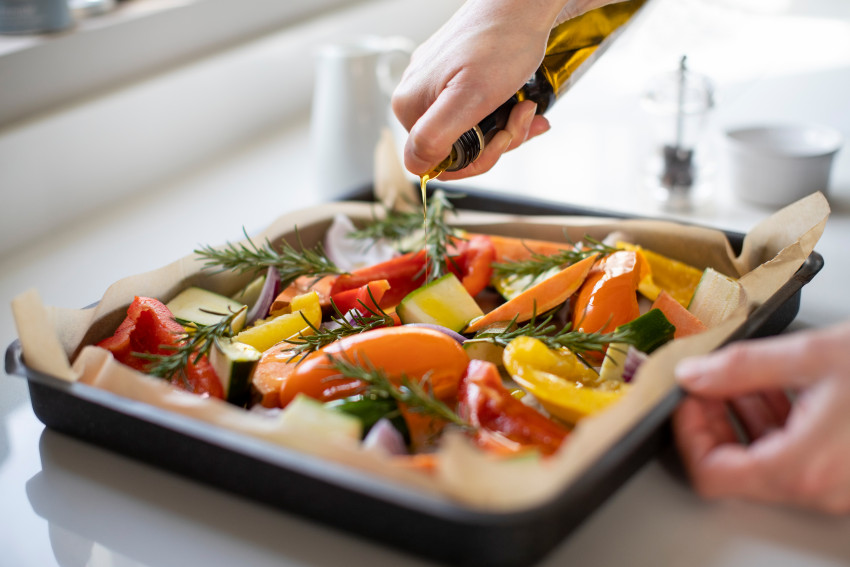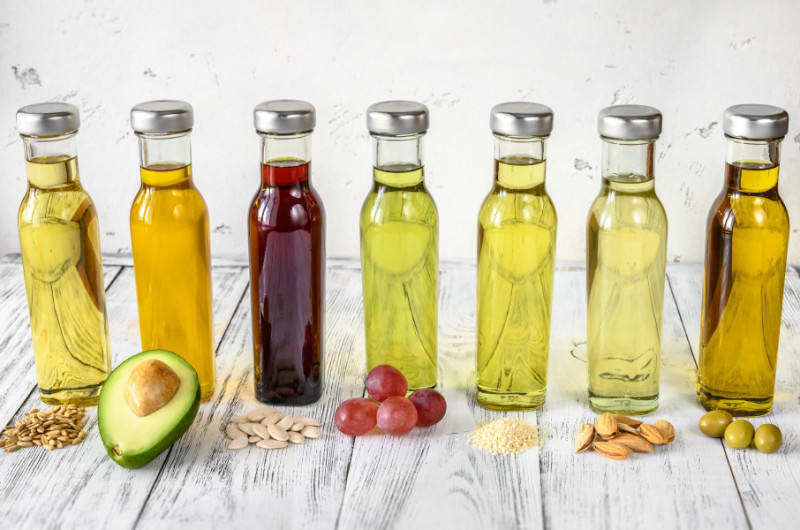By Chef Alli on May 26, 2021
A Guide to Cooking Oils

Extra-Virgin Olive Oil (EVOO)
Extra-virgin olive oil is a common cooking oil. Many cooks regularly use EVOO for baking and sauteing, along with making dressings, sauces and marinades. EVOO has a low smoke point when compared to other oils (it burns at a lower temperature), so it’s a good option for cooking on low to medium heat. EVOO shouldn’t be used for frying.
EVOO is one of the healthiest cooking oils, and many studies have linked EVOO to better heart health due to its large amount of monosaturated fats and polyunsaturated fatty acids.
True EVOO comes from the first pressing of the olives, and no heat or chemicals are used during the extraction process. It’s considered a high-quality oil; not refined in any way. EVOO retains the natural antioxidants and vitamins that can sometimes be lost during processing.
Many EVOOs have a very distinct (and sometimes strong) flavor, and it’s a good idea to do some taste testing to check out the flavor profiles available for purchase. EVOO boasts quite a range of flavors, from mildly sweet to peppery.
Olive Oil or Pure Olive Oil
At the grocery store, you’ll see oils labeled “olive oil” or “pure olive oil.” These are typically a blend of unprocessed virgin olive oil and refined olive oil. Olive oil and pure olive oil are processed, and heat and chemicals are usually used in their refinement. Pure olive oil is milder in flavor and is a good, all-purpose cooking oil, especially if your family is not a fan of the flavor of EVOO.
Light Olive Oil
Light olive oil is much softer in taste and color than other olive oils. Because light olive oil is very refined, it is great for sauteing, stir frying and roasting. The term “light” can create confusion; it is not lighter in calories, but lighter in flavor.
Understanding Olive Oil
At the most basic level, olive oil is the oil that’s pressed from the fruit of olive trees. Confusion arises when we fail to understand that different varieties of olive oil are differentiated by the process used to extract the oil.
Many cooks keep two types of olive oil in their kitchen; the first being a robust, good-quality EVOO. Due to its flavor, it’s perfect for drizzling over foods as a finishing touch. EVOO is wonderful for dressings, dips and crusty bread.
The second option is an all-purpose olive oil, like pure olive oil. An all-purpose olive oil is good for dishes where the flavor of the oil will be overwhelmed by other ingredients.
A good rule of thumb for choosing between EVOO and pure olive oil is this: the fewer ingredients, the higher the quality of oil. Go for the EVOO in recipes that don’t involve cooking or heat, so the flavor of the oil can shine.
Vegetable Oil
Most vegetable oils are a blend of corn, canola, soybean, safflower and sunflower oils, making it low-cost and accessible for most cooks.
Because vegetable oils are refined and highly processed, they are neutral in flavor. Vegetable oils are commonly used in recipes like marinades, dressings and sauces. They have a high smoke point of around 450 F. making the oil well-suited for frying, grilling, sauteing and baking.
Grapeseed Oil
Grapeseed oil is extracted from the seeds of grapes. It’s also a byproduct of wine making. Its neutral flavor will not overshadow other flavors.
Grapeseed oil is reasonably priced and is a versatile, everyday oil. Grapeseed oil has a high smoke point of about 400 F. When used for sauteing or stir frying, it gives foods a wonderfully crispy exterior.
Peanut Oil
Peanut oil is great for deep-frying because of its almost 500 F. smoke point. Peanut oil has a mildly nutty flavor and is made from pressing steam-cooked peanuts. It’s popular in Asian cuisines.
Peanut oil is unique; it does not absorb flavors from the foods that are fried in the oil. This means that many different foods can be cooked in the same batch of peanut oil without changing the flavor.
Peanut oil is a staple in large-scale fast-food operations where many types of foods can be cooked before the oil needs to be replaced.
There are two varieties of peanut oil, each with its own unique flavors and cooking properties.
Refined peanut oil is the most common peanut oil for cooking; it has been processed to make it a completely neutral cooking oil. The refinement process also removes nearly all allergens, making it safer for individuals with peanut allergies.
According to the FDA Allergen Labeling and Consumer Protection Act of 2004, refined peanut oil can be excluded from being labeled as a major food allergen.
Roasted peanut oil is the product of peanuts that are roasted prior to expelling their oils, creating an oil that is dark and golden brown in color. Because roasted peanut oil has a deep nutty flavor, it’s usually used for flavoring instead of cooking. Roasted peanut oil can be drizzled over cooked foods and is excellent in dressings.
Sunflower Oil
As you may have guessed, sunflower oil is extracted from sunflower seeds. Refined sunflower oil is commonly used as a frying oil due to its high smoke point. Cold-pressed, unrefined sunflower oil can be hard to find and is best in vinaigrettes and other low-heat applications.
Coconut Oil
Coconut oil comes in two forms: virgin and refined. Virgin coconut oil tastes like coconut while refined coconut oil is neutral in flavor. Coconut oil has a medium smoke point of 350 F. and works well for sauteing meat and vegetables.
Avocado Oil
Pressed from avocado pulp, avocado oil can contain up to 25 percent fat and boasts the highest smoke point of all plant-based cooking oils, with a flash point of about 510 F. The best uses for avocado oil are sauteing and frying, though its unique flavor is often incorporated into sauces and salad dressings.
Soybean Oil
Inexpensive with a neutral flavor profile, soybean oil is a great option for deep frying. The oil has a smoke point of about 450 F. Ideal for high-heat cooking methods like frying and sauteing, soybean oil can withstand hot temperatures without breaking down.
Soybean oil blends well with other fats and oils, making it ideal to blend into mayonnaise, vinaigrettes, creamy dips and tartar sauces.
Safflower Oil
Safflower oil is another oil with a high smoke point. Due to its mild flavor, safflower oil is ideal for everyday recipes, because it doesn’t overpower other ingredients. Most home cooks use safflower oil for baking or frying, and in dressings.
Flaxseed Oil
Also known as flax oil or linseed oil, flaxseed oil is the product of pressed ground flax seeds. Flaxseed oil is not used for cooking since it has a low smoke point of 225 F. Try using flaxseed oil as a finishing oil in dressings or dips.
Sesame Oil
Sesame oil is neutral in flavor with a high smoke point of 410 F., making it an all-purpose oil. Toasted sesame oil is much nuttier tasting, with a bigger flavor profile. Toasted sesame oil is often used in Asian, Middle Eastern and Mediterranean dishes, and it’s perfect for stir fry, fried rice, coating noodles and vinaigrettes.
Almond Oil and Walnut Oil
Both oils have a very low smoke point and big flavor. These oils should almost always be used as finishing oils on cold or room temperature dishes or drizzled over salads and roasted vegetables.








